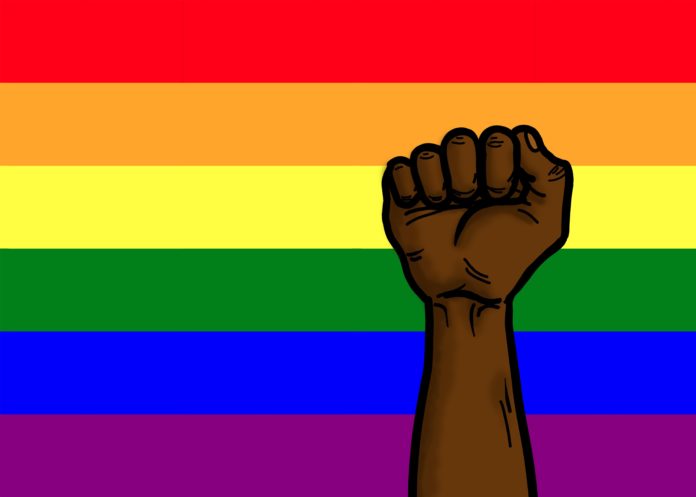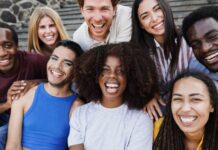
Gay pride rainbow flag with a fist hand raised of African-American person as a symbol of freedom, … [+]
Ernest Hopkins and Philip Pannell’s friendship was born out of activism and the fight for the betterment of people who love and look like them.
For Pannell, present in New York City’s West Village on the night of the Stonewall Uprising, the path to organizing was paved with pivotal protest moments such as the anti-Vietnam War movement and the present fight for the economic and societal justice for impoverished communities east of Washington, D.C.’s Anacostia River.
For Hopkins, his passion for the Black LGBTQIA community started during the late 80s and early 90s at the peak of the HIV/AIDS crisis. While largely ignored by the U.S. government, the HIV/AIDS crisis put the Black LGBTQIA community on the margins of society.
“I think it’s easy for people to forget how marginalized people living with HIV/AIDS were,” said Hopkins, one of D.C. Black Pride’s three founders. “And just how frequently it was the case that people’s families completely disowned them, disengaged from them, lied about what they died from.”
It is in this backdrop that a lifelong friendship formed.
ST/PANNELL 7/1/2004 jahi chikwendiu Phillip Pannel, a Ward 8 community activist in Washington, DC, … [+]
To many, Pannell and Hopkins’ friendship might seem run of the mill. But the truth is, these two Black gay men are the founding cornerstones of the Black Pride experience that millions experience yearly and the policy advancements that have slowed the spread of HIV/AIDS and uplifted the faces and voices of the Black LGBTQIA community in the U.S. and abroad.
MORE FOR YOU
Hopkins said his first interaction with Pannell followed an unforgettable radio interview. With a container filled with a fallen friend’s ashes next to him, Pannell used a radio interview focused on the epidemic to illuminate the problems plaguing the impoverished, oppressed, and those living in the shadows.
A couple of hours later, both Hopkins and Pannell convened at the same meeting to discuss the Black gay community’s response to the HIV/AIDs crisis. From that moment on, their friendship was one for the history book.
Ernest Hopkins is a D.C. native and founder of D.C. Black Pride.
On Memorial Day Weekend in 1991, with many suffering the health and economic impacts of HIV/AIDS, Hopkins, Welmore Cook and Theodore Kirkland established the first Black Gay Pride in the nation’s capital. To raise funds for those struggling during the epidemic and provide a social outing for the Black LGBTQ community, Black Pride became the first large-scale gathering of its kind.
“Everyone began to understand that it was more than just an HIV/AIDS fundraising event,” said Hopkins, who currently serves as senior advisor for the San Francisco AIDS Foundation. “Always with an HIV focus, Black Pride had the potential to be a significant messaging event for the Black LGBTQ community to be out and proud about it.”
While sadly losing Cook to HIV/AIDS after its first year, D.C. Black Pride is now in its 30th year of operation. At one point, it had just more than 800 participants who gathered at LeDroit Park across from Howard University. D.C., Black Pride 2022 attracts over 80,000 members of the Black LGBTQIA community and their allies.
The Black Pride movement has spread beyond D.C. to cities like Chicago, ; Los Angeles; Miami; and even Montego Bay, Jamaica. Under the umbrella of the Center for Black Equity (CBE), formerly known as the International Federation of Black Prides, Black Pride is now celebrated in more than 50 U.S. cities and across the globe.
According to the CBE website, Black Pride global is a celebration and movement dedicated to ending racism and homophobia and fighting for better access to health and mental health care in the Black community. Earl Fowlkes leads the Center.
NEW YORK, NY – JUNE 30: Head of the Center for Black Equity and 2013 Grand Marshall Earl Fowlkes … [+]
“It is very gratifying to watch how the movement has evolved,” said Hopkins, a D.C native. “Largely due to the leaders of Earl Fowlkes and his team at the Center for Black Equity, Black pride is now an international movement engaging the Black LGBTQ community around the world with professionalism, structure and pride.”
That pride and a firm conviction for the community binds the friendship between Hopkins and Pannell, whose pride beams through his oversized blazer, off-white sneakers and sticker-ladened clipboard.
“I realized that being Black, a gay, and also working-class poor, it was important to me to be active,” said Pannell, who is now in his 28th year leading the Anacostia Coordinating Committee (ACC).
The ACC is a non-profit membership consortium of individuals and organizations that unite around community issues, new development projects, and changes to Washington, D.C. policies. From his start at ACC, Pannell has been laser-focused on building bridges between poverty and the vulnerability of those who are Black and LGBTQIA.
Whether through the ACC’s efforts to revitalize Black neighborhood associations, fighting for equitable HIV/AIDs healthcare for predominately Black communities, or working to build a bridge between sexual identity and race, Pannell’s organizing for those that look and love like he is unrelenting.
“For a very long time, Philip was one of the most prominent openly Black gay people in the nation’s capital,” said Hopkins, recipient of the Congressional Black Caucus’ Leadership Award. “While focused on [the] low-income population east of the river, Philip brought a lot of political attention [to] the impact that HIV/AIDS was having on the Black community.”
Phillip Pannell addressing the D.C. Ward 8 Community.
As a native of Newport News, Virginia, or as he describes it, “a son of the segregated south,” Pannell’s organizing for gay liberation, which kicked off the summer of 1969 in the Greenwich Village, found a home in the District.
“When my late partner and I moved to D.C., we made the conscious decision to move into Ward 8,” said Pannell, an alumnus of Fordham University. “We as a couple believed we should do something to help our community. So we moved to the community we saw the most need.”
Since losing his partner, Pannell has continued his activism with Hopkins and others. Beyond just fighting for those surviving HIV/AIDS, Pannell has also been the leading voice on marriage equality and has served as one of the leading voices on crime prevention, COVID-19 pandemic response, and economic empowerment for those living at the intersection of being Black and LGBTQIA.
Like Pannell, Hopkins’ fight forward has continued since that Memorial Day weekend in 1991.
“If your community is in crisis and you see that action is required, you have to take it upon yourself to do something,” said Hopkins, in response to his long legacy of action against America’s HIV/AIDS crisis.
As a founder of both Black Pride and a one-time leader in the Capital Pride festival, Hopkins has been a leading advocate for changing how the Centers for Disease Control and Prevention responded to the proliferation of HIV/AIDS among Black gay men. And he led the way in establishing the National Black Gay Men’s Advocacy Coalition—a group of advocates committed to improving the health of Black gay men through advocacy, research, policy, and education.
Beyond that, Hopkins has also served as the leading voice in the passage of the Ryan White HIV/AIDS Treatment Extension Act of 2009.
US President Barack Obama (C) signs the Ryan White HIV/AIDS Treatment Extension Act of 2009 with … [+]
When asked about the future of organizing in the Black LGBTQIA community, Pannell and Hopkins expressed pride in the current generation’s willingness to be seen. They pointed to the success of programs like HBO’s Legendary and more Black LGBTQ candidates on that ballot as a throughline from the activism of the late 80s and early 90s.
“Our increased visibility in the media would have been very unlikely to have just spontaneously occurred had there not already been a culture in the community across the United States of Black LGBTQ folks being visual,” said Hopkins. “All those thousands of people who show up for pride in Los Angeles, Detroit, Washington, D.C., Houston, Dallas, or Miami. That’s who you’re talking to.”
While these Pride elders continue to work for their community, they also urge others to join in the fight.
“If I could wave a magic wand, not a single tenant would be living in a rental building that does not have a functional, viable, and productive tenant association,” Pannell said. “If you’re going to talk about the empowerment of people, you’ve got to empower them where they live. This should be a three-step approach, from tenant organizing, we go to neighborhoods and then the city at large.”
“It’s just not okay to tolerate unacceptable situations. You have to take your power and use it for good,” Hopkins said.








